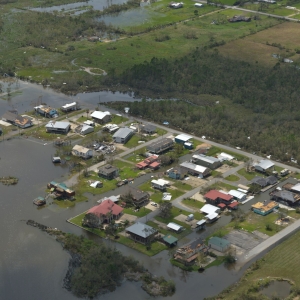The Stream, September 1, 2020: Record-Breaking August Rains Flood Districts Across India
The Global Rundown
India experiences its highest level of rainfall in the month of August since 1983. Flooding in Sudan has impacted almost 400 thousand since July. New findings on microplastics in agricultural fields could threaten food supplies globally. The U.S. Gulf Coast battles the aftermath of Hurricane Laura and the Covid-19 pandemic. Pacific islanders may be at higher risk for Covid-19 outbreaks due to a lack of access to water and sanitation.
“The rural women would like to have access to water and sanitation so they can protect themselves and their families from Covid-19, but this is very difficult because the movement of people is restricted and so is transportation.” – Maria Linibi, a villager in Intoap village in Papua New Guinea’s Morobe Province. Case numbers for Covid-19 have jumped from 11 to 424 in just two months in Papua New Guinea (PNG), which public health experts say can be attributed a lack of access to clean water. Data has indicated that people in the Pacific have the least amount of access to basic drinking water and access to proper sanitation is the second worst in the world. Although coronavirus cases in Pacific island nations make up a tiny fraction of cases worldwide, the risk lies in their fragile ability to control rapid infection through vulnerable communities. The Guardian
Latest WaterNews from Circle of Blue
Water Serves Length and Breadth of $1.9 Trillion Texas Economy – Across Texas, ties between water and the economy are revealed in innumerable places, in sturdy connections that bind the state together.
HotSpots H2O: First Covid Case Linked to Community Spread Rattles Gaza – Gaza authorities announced last week the first Covid-19 case in the Palestinian enclave that was spread through the community amid health inequities, ongoing conflict and a longstanding lack of adequate water in the Gaza Strip that have left two million Palestinians intensely vulnerable to the Covid-19 pandemic.
What’s Up With Water—August 31, 2020 – This week’s episode looks at the eradication of the wild poliovirus in Africa, insecure groundwater supplies globally and the threat of cyanobacteria in the Des Moines River.
By The Numbers
24 The number of people found dead after India’s Narmada River overflowed and water released from the Hirakud Dam flooded several districts over the weekend. Thousands have been displaced in other parts of the country as the India Meteorological Department (IMD) reported the highest levels of rainfall for the month of August in 44 years. Rescue operations have been underway since Friday evening. India’s Chief minister Shivraj Singh Chouhan said that 454 villages in 12 districts were affected by the floods, and over 9,000 people have been moved to relief camps. Hindustan Times
380,000+ The number of people who have been affected by heavy rains and flash floods since mid-July in Sudan. Nearly 90 people have died and over 76,000 homes have been damaged or completely destroyed. Access to clean water, in the midst of the Covid-19 pandemic, has also been affected. Around 2,000 water sources are now contaminated or non-functional. The Bout Earth Dam in Blue Nile State also collapsed on July 29, which could compromise the water supply of over 100,000 people, including internally displaced persons (IDPs) and refugees. As above-average rains are predicted to continue until the end of September, the situation is expected to worsen over the coming weeks. ReliefWeb
Science, Studies, and Reports
A growing body of research is finding that microplastics, or pieces of plastic smaller than five millimeters across, are found more commonly in farm soils. Luca Nizzetto, a research scientist at the Norwegian Institute for Water Research, found that agriculture was a “hot area” for potential land sinks for microplastics. Microplastics can enter agricultural lands via sewage sludge, the solids that are filtered out of wastewater and are commonly used to fertilize agricultural fields. New research has found that those microplastics can accumulate on the crops themselves, meaning they could be found in meat and dairy products as well, if the animals eat the crops. Environmental Health News
In context: ‘It’s Raining Plastic’: Researchers Find Microscopic Fibers in Colorado Rain Samples
On the Radar
Residents along the U.S. Gulf Coast are coping with the aftermath of Hurricane Laura while still trying to keep the coronavirus pandemic under control. More than 600,000 storms were caught in the path of the storm, which caused widespread power outages and disrupted the water system at a time when Covid-19 cases were already spiking in many southern states. To abide by Covid-19 guidelines, fewer shelters are being set up to house displaced people and first responders worry they could expose themselves to the virus during search and rescue missions. NPR
In context: In Pandemic, New Thinking on Responding to Weather Disasters
Jane is a Communications Associate for Circle of Blue. She writes The Stream and has covered domestic and international water issues for Circle of Blue. She is a recent graduate of Grand Valley State University, where she studied Multimedia Journalism and Women, Gender and Sexuality Studies. During her time at Grand Valley, she was the host of the Community Service Learning Center podcast Be the Change. Currently based in Grand Rapids, Michigan, Jane enjoys listening to music, reading and spending time outdoors.




Leave a Reply
Want to join the discussion?Feel free to contribute!